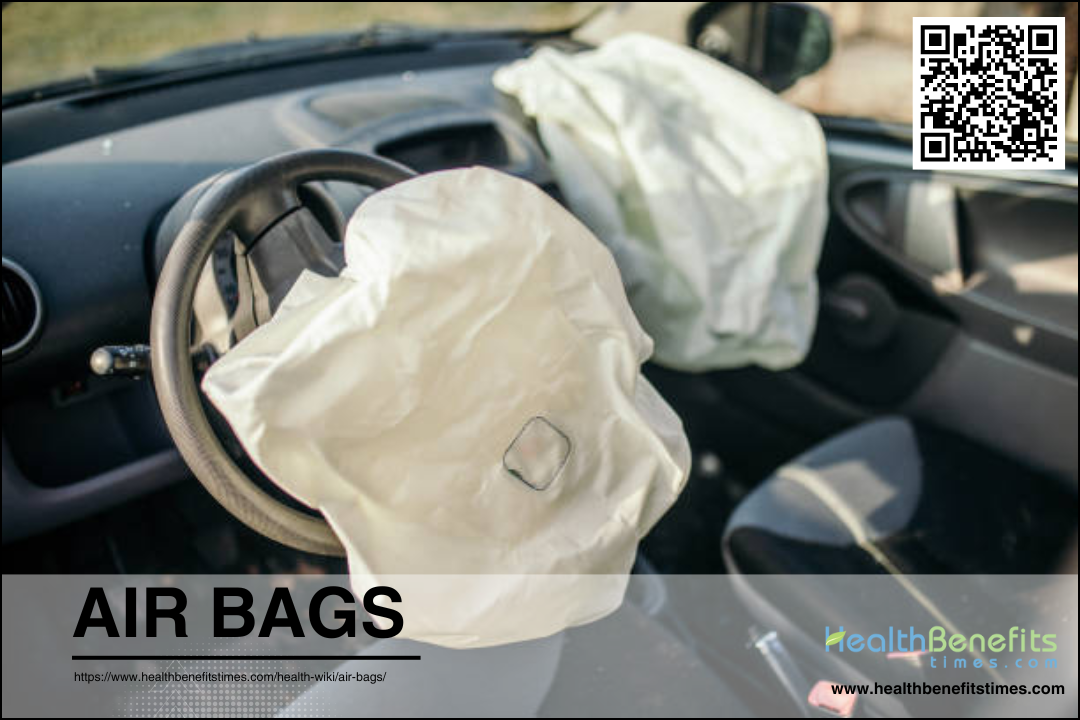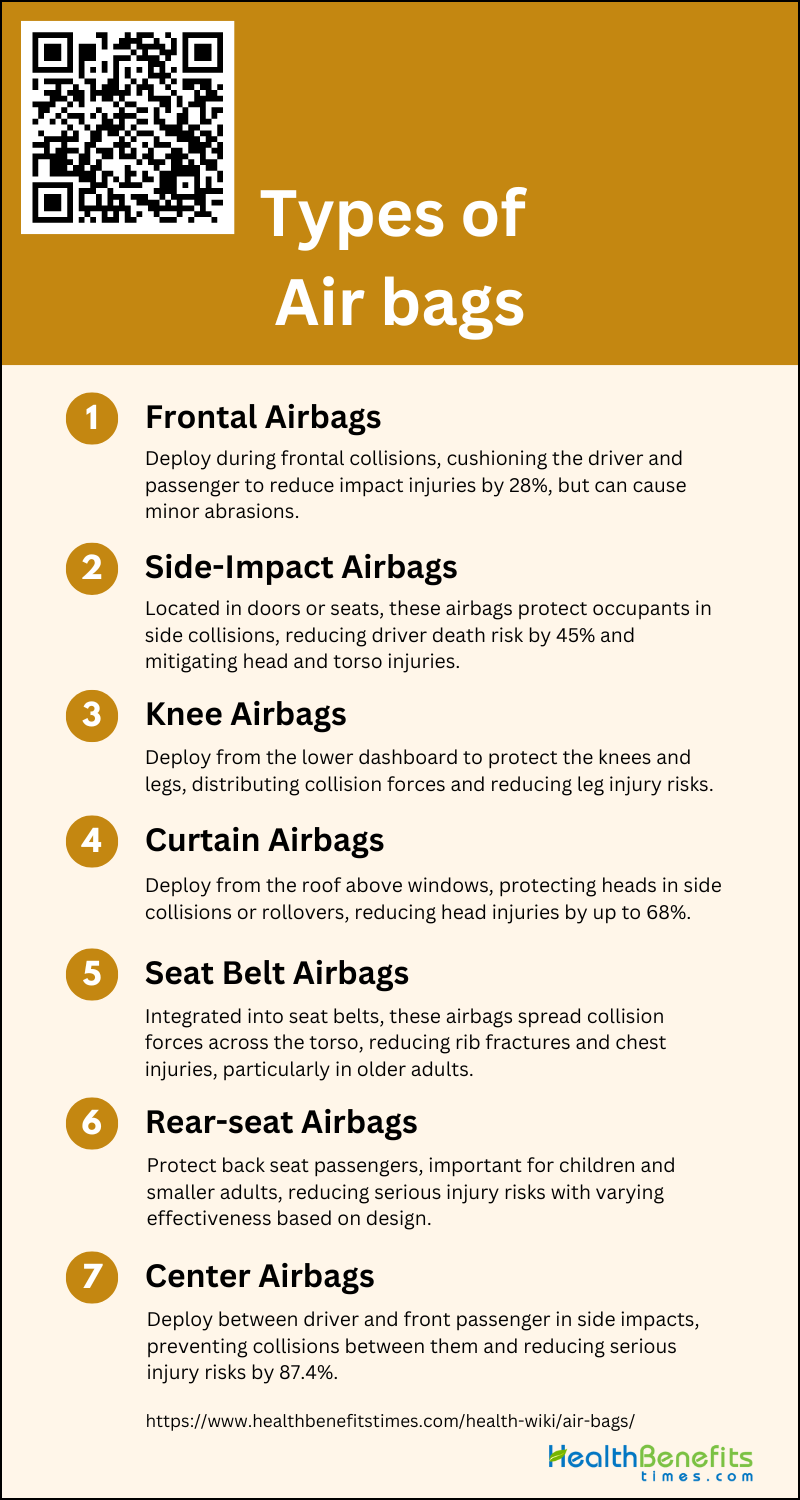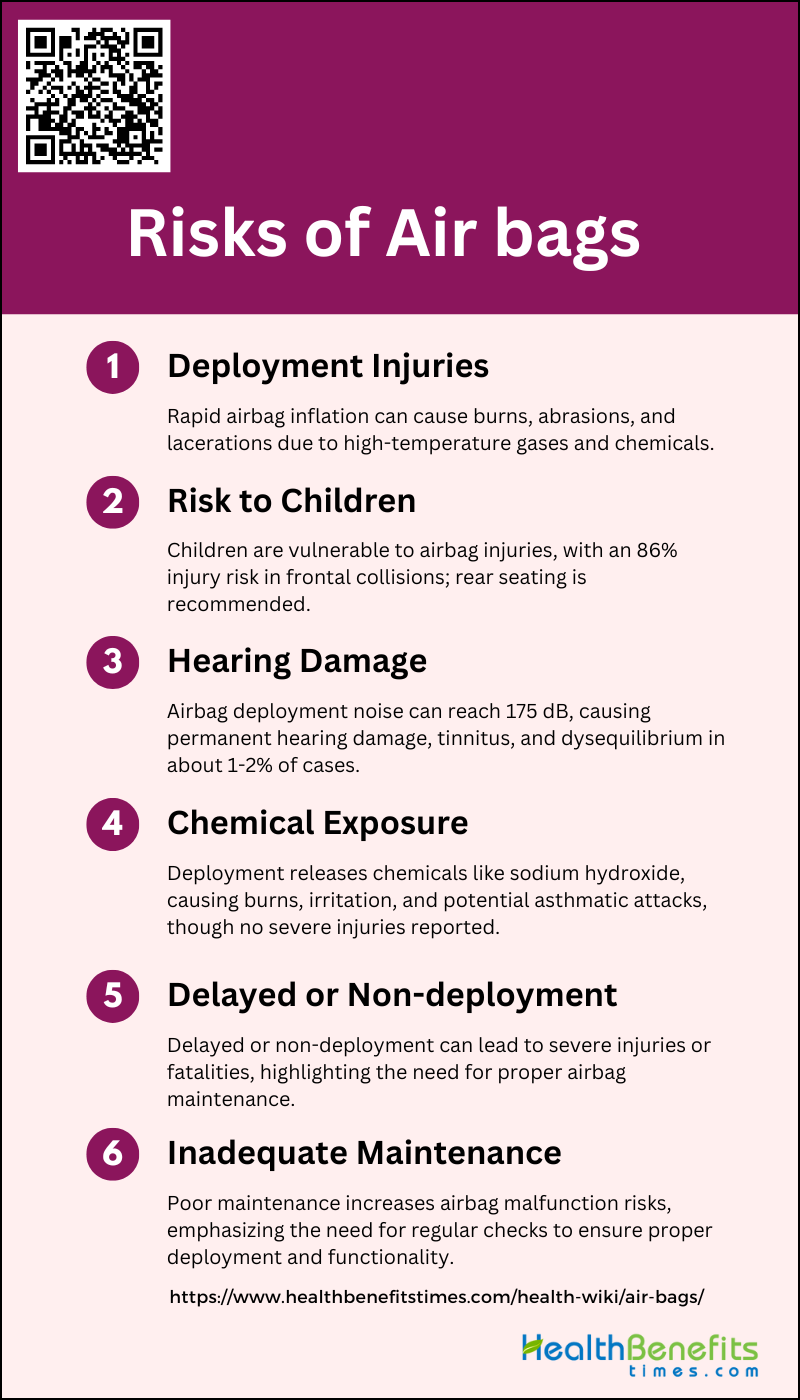 Airbags are a crucial passive safety feature in modern vehicles, designed to provide a protective cushion for occupants during a collision. They work by rapidly inflating upon impact, thanks to sensors that detect sudden deceleration and trigger a chemical reaction to produce gas, filling the airbag in less than 1/20th of a second. Positioned in various parts of the vehicle, including the steering wheel, dashboard, sides, and even the roof, airbags help to reduce the risk of injury by preventing occupants from striking hard surfaces inside the car. While they significantly enhance safety, airbags are most effective when used in conjunction with seatbelts, as they are designed to complement this primary restraint system.
Airbags are a crucial passive safety feature in modern vehicles, designed to provide a protective cushion for occupants during a collision. They work by rapidly inflating upon impact, thanks to sensors that detect sudden deceleration and trigger a chemical reaction to produce gas, filling the airbag in less than 1/20th of a second. Positioned in various parts of the vehicle, including the steering wheel, dashboard, sides, and even the roof, airbags help to reduce the risk of injury by preventing occupants from striking hard surfaces inside the car. While they significantly enhance safety, airbags are most effective when used in conjunction with seatbelts, as they are designed to complement this primary restraint system.
How Airbags Work?
Airbags are sophisticated safety devices designed to protect vehicle occupants during collisions by providing a cushioning effect that reduces bodily injuries. They are typically made from woven fabric that is impermeable to gases and flame resistant, and they deploy rapidly upon detecting a collision through electronic crash sensors. These sensors trigger the inflator, which uses a pyrotechnic device to convert sodium azide into nitrogen gas, inflating the airbag within milliseconds. Modern airbags are equipped with smart restraint systems that adjust deployment based on crash severity, occupant size, and proximity to the airbag. While airbags significantly reduce the risk of death and serious injuries, they can also cause specific injuries such as thermal burns, chemical keratitis, and mechanical injuries from the rapid deployment. Continuous advancements in airbag technology, including the integration of tactile sensors and controlled venting, aim to enhance their effectiveness and safety.
Where are airbags located?
The primary airbags are typically installed in the steering wheel for the driver and in the dashboard for the front passenger, as mandated by the National Highway Traffic Safety Administration since 1997. Additionally, side airbags are integrated into the sides of the seats or the doors to protect occupants during side-impact crashes, effectively reducing the risk of death or injury to the head, neck, face, chest, and abdomen. Side curtain airbags, which deploy from the roof lining above the windows, provide further protection by covering the side windows during a collision, thereby reducing head injuries. These airbags are designed to deploy in response to specific crash conditions detected by electronic sensors, ensuring rapid inflation to cushion and protect occupants from severe injuries.
Types of Air bags
There are various types of airbags installed in vehicles, each serving a specific purpose to enhance overall safety. Below is a list of the most common types of airbags found in modern vehicles:
1. Frontal Airbags
Frontal airbags are designed to deploy in the event of a frontal collision, providing a cushion that helps to reduce the impact on the driver and front passenger. These airbags have been shown to significantly reduce driver fatalities in frontal crashes by about 28% compared to vehicles equipped only with manual belts. They work in conjunction with seat belts to prevent severe injuries, particularly to the head and torso, by mitigating whiplash-type motions. However, they are not without risks, as they can cause minor injuries such as abrasions and burns due to the high-speed deployment and the chemicals involved.
2. Side-Impact Airbags
Side-impact airbags are designed to protect occupants during side collisions. These airbags can be located in the doors or seats and are intended to shield the torso and head. Studies have shown that side airbags, particularly those that protect both the head and torso, can reduce the risk of driver death in side collisions by up to 45%. They are effective in reducing biomechanical responses for the head and chest, significantly lowering the head injury criterion (HIC) and viscous response (VC) in crash tests7. However, the effectiveness can vary depending on the type of side airbag and the specifics of the collision.
3. Knee Airbags
Knee airbags are designed to deploy from the lower dashboard to protect the knees and legs of the driver and front passenger. These airbags help to distribute the force of a collision more evenly across the body, reducing the risk of leg injuries. While specific studies on knee airbags are less common, they are generally considered an important addition to the overall safety system of a vehicle, complementing other airbags by providing additional protection to the lower extremities.
4. Curtain Airbags
Curtain airbags deploy from the roof lining above the windows and are designed to protect the heads of occupants in the event of a side collision or rollover. These airbags can cover the windows of both the front and rear seats, providing extensive protection. Research indicates that curtain airbags are highly effective in reducing head injuries, with some studies showing a reduction in head injury criterion (HIC) by up to 68% in side impacts. They are particularly beneficial in preventing ejection from the vehicle during a rollover.
5. Seat Belt Airbags
Seat belt airbags are integrated into the seat belts themselves and are designed to deploy in a collision to spread the force of the impact over a larger area of the occupant’s torso. This can help to reduce the risk of rib fractures and other chest injuries. While not as widely studied as other types of airbags, seat belt airbags are considered a valuable addition to vehicle safety systems, particularly for older adults who may be more susceptible to chest injuries.
6. Rear-seat Airbags
Rear-seat airbags are designed to protect passengers in the back seats during a collision. These airbags can be integrated into the back of the front seats or the roof lining. They are particularly important for protecting children and smaller adults, who may be more vulnerable to injuries in a crash. Studies suggest that rear-seat airbags can significantly reduce the risk of serious injuries for rear-seat passengers, although their effectiveness can vary depending on the specific design and deployment mechanism.
7. Center Airbags
Center airbags are a newer type of airbag designed to deploy between the driver and front passenger to prevent them from colliding with each other during a side impact. These airbags can also help to protect occupants from intrusions into the cabin during a collision. Research indicates that center airbags can reduce the number of serious injuries in side impacts, contributing to a significant reduction in the Maximum Abbreviated Injury Scale (MAIS) of 3 or above by 87.4%. They are particularly effective in vehicles with high market penetration rates and appropriate pricing strategies.
Benefits of Airbags
They work in tandem with seatbelts to reduce the risk of serious injuries by cushioning the impact. Here are some key benefits that airbags provide:
1. Lifesaving Potential
Studies have shown that airbag deployment can reduce driver mortality by up to 63% in head-on collisions, especially when combined with seat belt use, which further enhances the protective effect. The combination of airbags and seat belts can reduce mortality by more than 80%, highlighting the critical role of airbags in occupant protection systems. Additionally, airbags have been found to prevent or reduce brain injuries in approximately 25% of hospitalized brain-injured patients, underscoring their lifesaving potential.
2. Injury Reduction
They primarily prevent head and chest injuries by cushioning the impact and preventing contact with hard surfaces like the steering wheel and dashboard. Research indicates that airbags significantly reduce the probability of sustaining moderate to severe injuries, particularly to the head, face, and chest. However, there is also evidence of an increase in minor injuries, such as abrasions and bruises, due to airbag deployment. Despite this, the overall reduction in severe injuries makes airbags a crucial safety feature.
3. Protection in Frontal Collisions
This studies shows that airbags reduce driver fatalities by about 22% in frontal crashes when used in conjunction with seat belts. The deployment of airbags in frontal impacts helps to control the deceleration of the brain, reducing the risk of brain trauma and cervical spine injuries. Furthermore, airbags have been shown to offer similar protection for front-seated occupants in vehicles equipped with both first- and second-generation airbags, although the latter may provide slightly less protection due to their depowered nature.
4. Improved Rollover Protection
While airbags are primarily designed for frontal collisions, they also offer some level of protection in rollover accidents. Case studies have reported instances where airbags, in combination with seat belts, have protected occupants from severe injuries in rollover crashes. Although the primary efficacy of airbags in non-frontal collisions is less well-documented, their role in providing additional protection in such scenarios cannot be overlooked. The combination of airbags and seat belts remains the most effective occupant protection system in various types of motor vehicle crashes.
5. Advanced Technology Integration
The integration of advanced technology in airbag systems has further enhanced their effectiveness. Modern airbags are equipped with sensors and algorithms that optimize deployment based on the severity and type of collision. This technological advancement has led to a reduction in the risk of injuries associated with airbag deployment, such as thermal injuries and chemical keratitis. Additionally, the revision of test criteria for airbags in the USA in 1997 has improved their effectiveness, particularly for belted drivers. These advancements ensure that airbags continue to evolve as a critical component of vehicle safety systems.
Risks of Air bags
From the potential for malfunction to the injuries they can cause when deployed, understanding these risks is essential for drivers and car manufacturers alike. Below is a list of the primary risks associated with airbags.
1. Deployment Injuries
The rapid inflation process involves the release of high-temperature gases and chemicals, which can lead to burns, abrasions, and lacerations. Studies have shown that more than 7% of air bag-related injuries are burns, typically involving the upper extremity, head, or neck. Additionally, the deployment can cause traumatic lesions such as irritant dermatitis, chemical burns, and thermal burns. Despite these risks, the benefits of air bags in preventing more severe injuries often outweigh these minor injuries.
2. Risk to Children
Children are particularly vulnerable to injuries from air bag deployment. Research indicates that children exposed to passenger air bags (PABs) in frontal impact collisions have a significantly higher risk of both minor and serious injuries. The overall risk of any injury was found to be 86% among children exposed to PABs, compared to 55% in the comparison group. Serious injuries can include upper extremity fractures and ocular trauma, such as corneal abrasions and traumatic iritis. It is recommended that children travel in the rear seat to minimize these risks.
3. Hearing Damage
The noise generated by air bag deployment can cause significant hearing damage. Studies involving animal models have shown that the intense noise levels, which can reach up to 175 dB, exceed current occupational standards for noise-related ear injury . This intense noise can lead to permanent auditory injuries in about 1-2% of deployments. Symptoms can include transient and permanent hearing loss, tinnitus, and dyse quilibrium . Therefore, the auditory hazard of air bag noise is a significant concern that needs to be addressed.
4. Chemical Exposure
Air bag deployment involves the release of various chemicals, including sodium hydroxide, which can cause chemical burns and other injuries. The white powdery residue found in the driver compartment after deployment is a combination of talc and sodium hydroxide, which can lead to dermal burns and irritation. Chemical exposure can also provoke asthmatic attacks in sensitive individuals and delay the healing of wounds. Despite these risks, no chemical injuries have been reported as a result of air bag deployment in motor vehicle accidents.
5. Delayed or Non-deployment
Delayed or non-deployment of air bags can result in severe injuries or fatalities that could have been prevented. While the provided data does not specifically address this issue, it is well-known that the failure of air bags to deploy in a timely manner can negate their life-saving potential. Ensuring that air bags are properly maintained and that their deployment mechanisms are functioning correctly is crucial for maximizing their effectiveness in protecting vehicle occupants.
6. Inadequate Maintenance
Inadequate maintenance of air bag systems can lead to their malfunction, increasing the risk of injury during a crash. Proper handling and familiarity with the effects and side effects of modern restraint systems are essential to minimize the risk of adverse effects. Regular checks and maintenance of air bag systems are necessary to ensure they function correctly when needed. Failure to do so can result in either non-deployment or unintended deployment, both of which pose significant risks to vehicle occupants.




